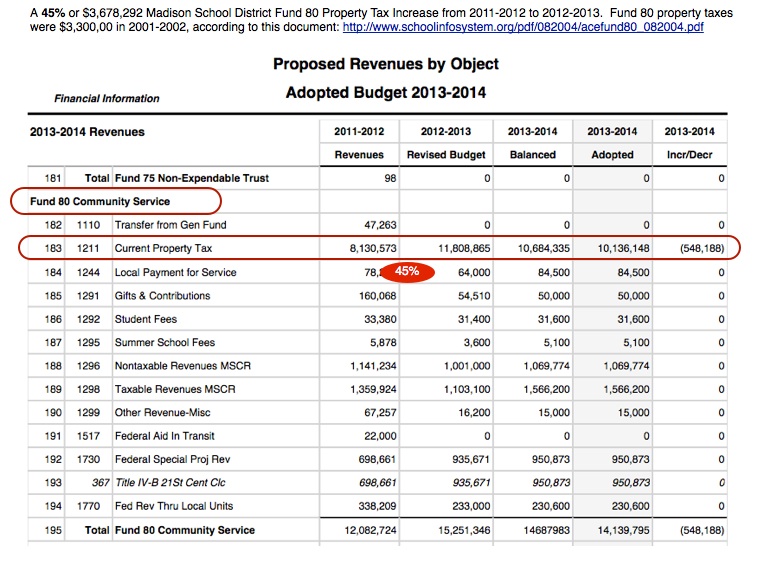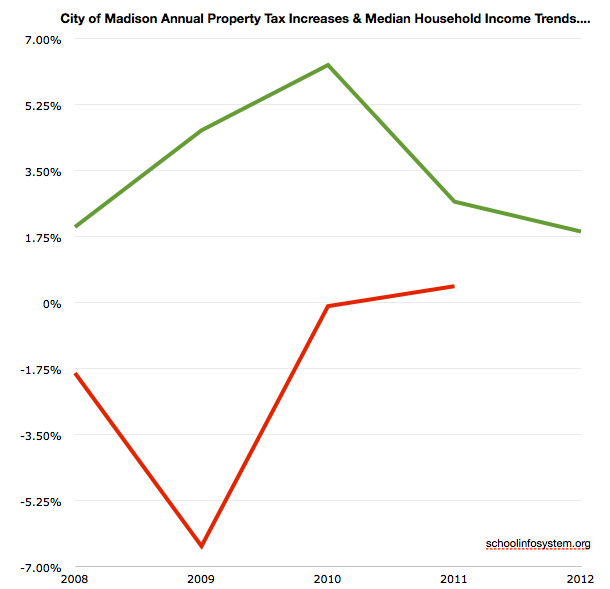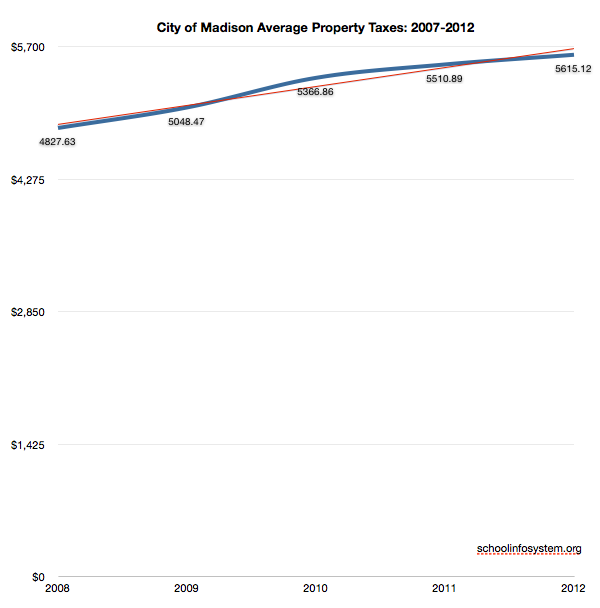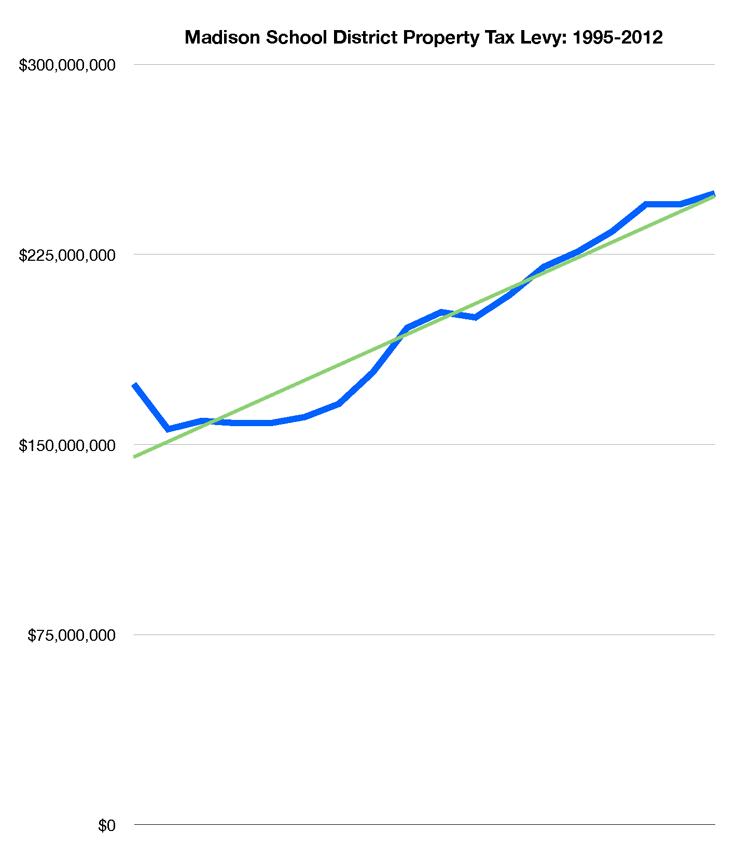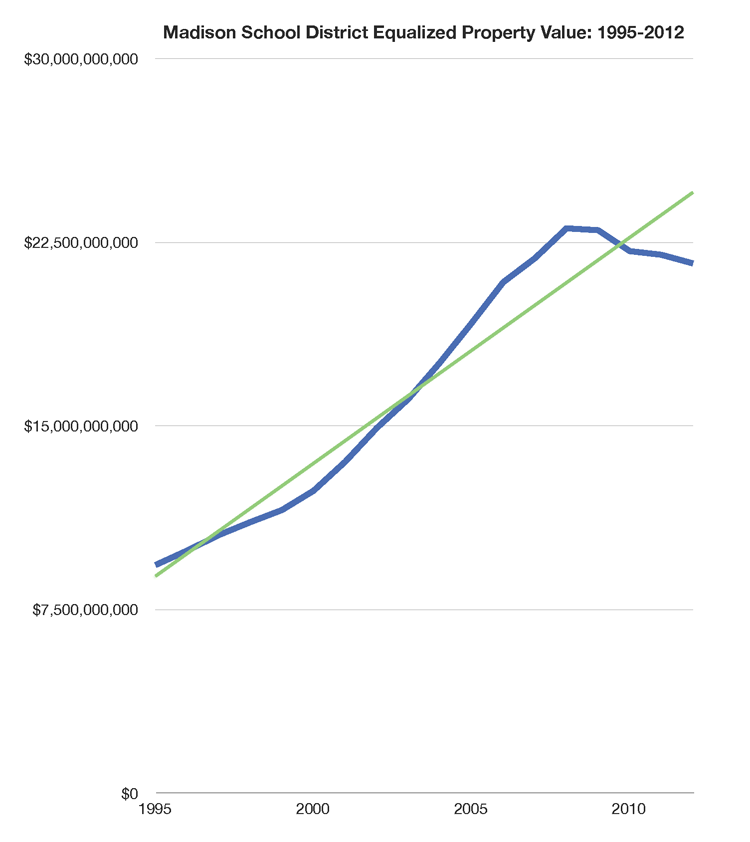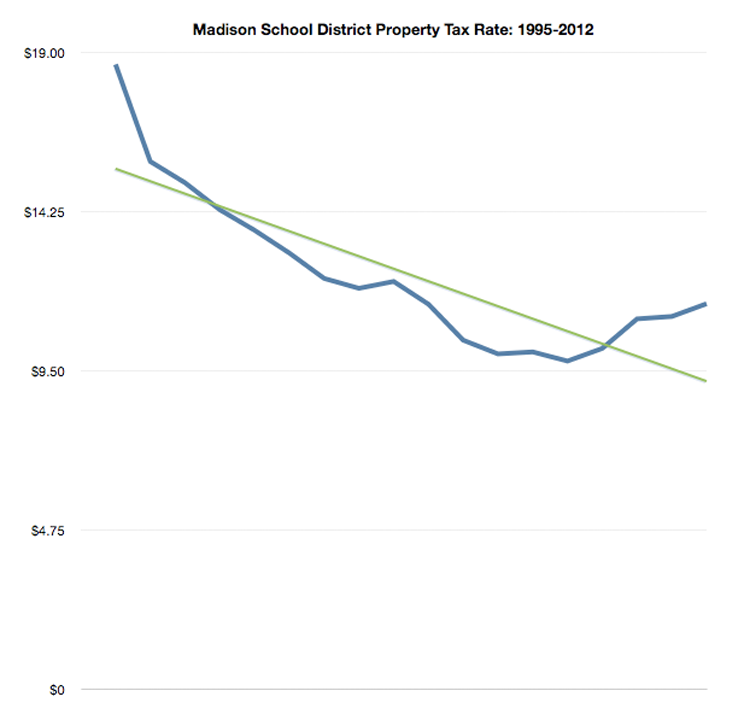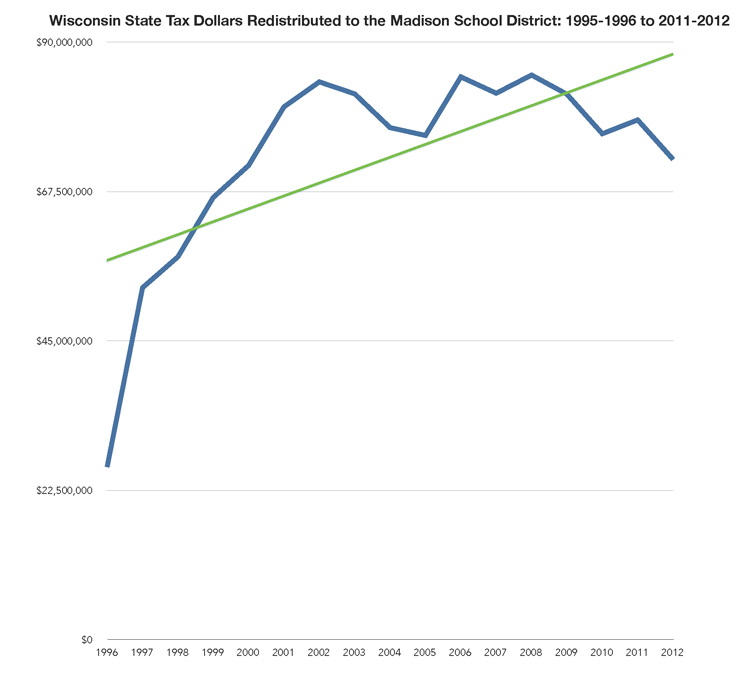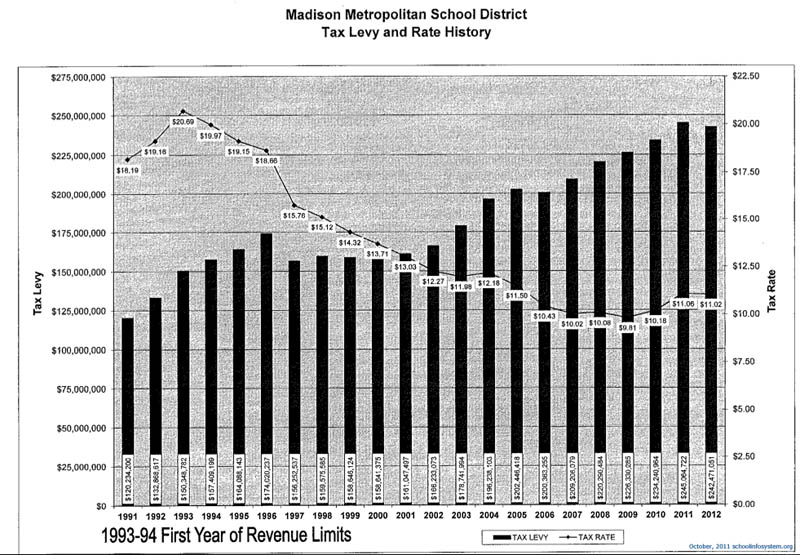Search Results for: %22FUnd 80%22
Madison Schools’ 2014-2015 $402,464,374 Budget Document (April, 2014 version)
The Madison School District (3MB PDF): Five Priority Areas (just like the “Big 10”) but who is counting! – page 6: – Common Core – Behavior Education Plan – Recruitment and hiring – New educator induction – Educator Effectiveness – Student, parent and staff surveys – Technology plan 2014-2015 “budget package” 3MB PDF features some […]
Madison’s Proposed Property Tax Increase: Additional links, notes and emails
I received a kind email from Madison School Board President Ed Hughes earlier today regarding the proposed property tax increase associated with the 2013-2014 District budget.
Ed’s email:Jim —
Your comparison to the tax rates in Middleton is a bit misleading. The Middleton-Cross Plains school district that has a mill rate that is among the lowest in Dane County. I am attaching a table (.xls file) that shows the mill rates for the Dane County school districts. As you will see, Madison’s mill rate is lower than the county average, though higher than Middleton’s. (Middleton has property value/student that is about 10% higher than Madison, which helps explain the difference.)
The table also includes the expenses/student figures relied upon by DPI for purposes of calculating general state aid for the 2012-13 school year. You may be surprised to see that Madison’s per-student expenditures as measured for these purposes is among the lowest in Dane County. Madison’s cost/student expenditures went up in the recently-completed school year, for reasons I explain here: http://tinyurl.com/obd2wty
EdMy followup email:
Hi Ed:
Thanks so much for taking the time to write and sending this along – including your helpful post.
I appreciate and will post this information.
That said, and as you surely know, “mill rate” is just one part of the tax & spending equation:
1. District spending growth driven by new programs, compensation & step increases, infinite campus, student population changes, open enrollment out/in,
2. ongoing “same service” governance, including Fund 80,
3. property tax base changes (see the great recession),
4. exempt properties (an issue in Madison) and
5. growth in other property taxes such as city, county and tech schools.
Homeowners see their “total” property taxes increasing annually, despite declining to flat income. Middleton’s 16% positive delta is material and not simply related to the “mill rate”.
Further, I continue to be surprised that the budget documents fail to include total spending. How are you evaluating this on a piecemeal basis without the topline number? – a number that seems to change every time a new document is discussed.
Finally, I would not be quite as concerned with the ongoing budget spaghetti if Madison’s spending were more typical for many districts along with improved reading results. We seem to be continuing the “same service” approach of spending more than most and delivering sub-par academic results for many students. (Note the recent expert review of the Madison schools Analysis: Madison School District has resources to close achievement gap.)
That is the issue for our community.
Best wishes,
Jim
Related: Middleton-Cross Plains’ $91,025,771 2012-2013 approved budget (1.1mb PDF) for 6,577 students, or $13,840.01 per student, roughly 4.7% less than Madison’s 2012-2013 spending.
45% (!) Increase in Madison Schools’ Fund 80 Property Taxes from the 2011-2012 to 2012-2013 School Year; No Mention of Total Spending
July, 2013 Madison Schools 2013-2014 Budget Presentation (PDF). Notes:
- No mention of total spending…. How might the Board exercise its oversight obligation without the entire picture?
- The substantial increase in redistributed state tax dollars (due to 4K) last year is not mentioned. Rather, a bit of rhetoric: “The 2013-14 budget development process has focused on actions which begin to align MMSD resources with the Strategic Framework Priorities and strategies to manage the tax levy in light of a significant loss of state aid.” In fact, according to page 6, the District expects to receive $46,392,012 in redistributed state tax dollars, which is a six (6%) increase over the funds received two years ago.
- The District’s fund equity (financial cushion, or reserves) has more than doubled in the past eight years, from $22,368,031 in 2005 to $46,943,263 in 2012.
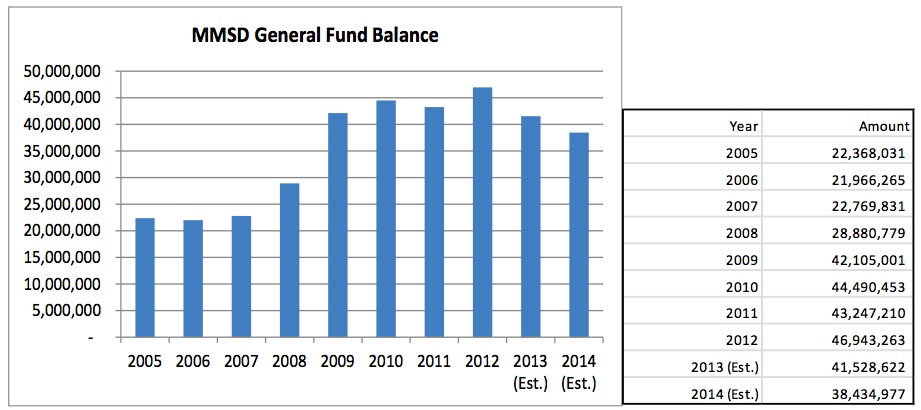
- Outbound open enrollment continues to grow, up 14% to 1,041 leavers in 2013 (281 inbound from other Districts).
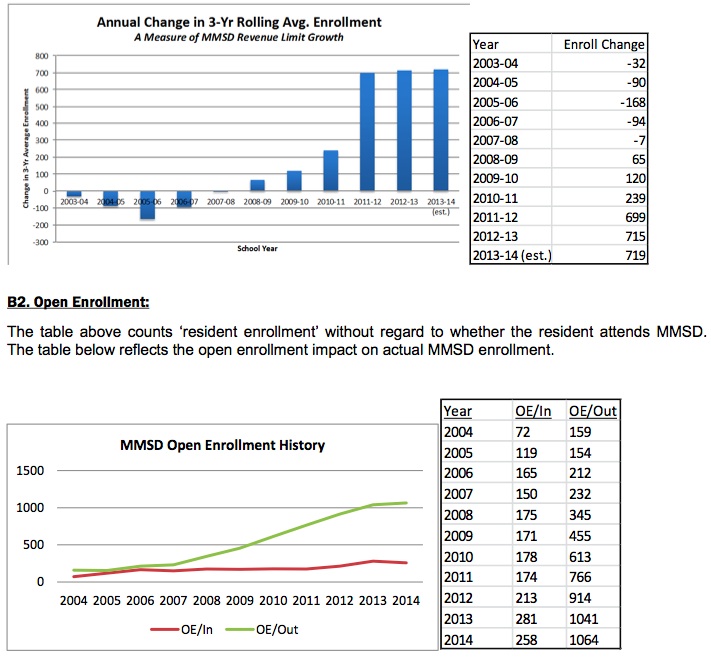
- There is no mention of the local tax or economic base:

- The growth in Fund 80 (MSCR) property taxes and spending has been controversial over the years. Fund 80, up until recently was NOT subject to state imposed property tax growth limitations.
- Matthew DeFour briefly summarizes the partial budget information here. DeFour mentions (no source referenced or linked – in 2013?) that the total 2013-2014 budget will be $391,000,000. I don’t believe it:
The January, 2012 budget document mentioned “District spending remains largely flat at $369,394,753” (2012-2013), yet the “baseline” for 2013-2014 mentions planned spending of $392,807,993 “a decrease of $70,235 or (0.02%) less than the 2012-13 Revised Budget” (around $15k/student). The District’s budget generally increases throughout the school year, growing 6.3% from January, 2012 to April, 2013. Follow the District’s budget changes for the past year, here.
Finally, the document includes this brief paragraph:
Work will begin on the 2014-15 early this fall. The process will be zero-based, and every line item and FTE will be carefully reviewed to ensure that resources are being used efficiently. The budget development process will also include a review of benefit programs and procurement practices, among other areas.
One hopes that programs will indeed be reviewed and efforts focused on the most urgent issues, particularly the District’s disastrous reading scores.
Ironically, the recent “expert review” found that Analysis: Madison School District has resources to close achievement gap. If this is the case (and I agree with their conclusion – making changes will be extraordinarily difficult), what are students, taxpayers and citizens getting for the annual tax & spending growth?
I took a quick look at property taxes in Middleton and Madison on a $230,000 home. A Middleton home paid $4,648.16 in 2012 while a Madison home paid 16% more, or $5,408.38.
Wisconsin Leglislative Fiscal Bureau Budget Memo on Fund 80 and School Related Changes
Bob Lang, Wisconsin Legislative Fiscal Bureau (PDF):
COMMUNITY SERVICE LEVY (FUND 80)
Prohibit a district from levying more for community service activities in 2013-14 and 2014- 15 than it did in the most recent year preceding 2013-14 in which the district levied for those activities. Provide that if a district wishes to exceed the limit on the community service levy, the school board could adopt a resolution to exceed the limit by a specified amount and submit the resolution to the electors of the district for approval. Specify that the limit otherwise applicable to the district would be increased by the amount approved by a majority of those voting on the question.
Under ASA 1, a school district would be prohibited from levying more for community service activities in 2013-14 and 2014-15 than it did in 2012-13.
3. PARENTAL CHOICE PROGRAMS — STUDENT PRIORITY
Specify that under the ~xpandedchoice program outside of Milwaukee and Racine, a private school would be required to give preference to a pupil who satisfies either of the following: (a) the pupil was enrolled in a public school in the school district in the previous year and is applying to attend the school in grades 2 through 8 or 10 through 12; or (b) the pupil was not enrolled in school in the previous school year.
Under current law, choice schools must select pupils on a random basis, except that they may give preference in accepting applications to siblings of pupils selected on a random basis. Under ASA 1, schools would be allowed to give preference in accepting applications to any of the following: (a) pupils who attended the school under the choice program during the school year prior to the school year for which the application is being made; (b) siblings of pupils who attended the school during the school year prior to the school year for which the application is being made and to siblings of pupils who have been accepted to the school for the school year for which the application is being made; and (c) pupils who attended another school under a parental choice program during the school year prior to the school year for which the application is being made.
PARENTAL CHOICE PROGRAMS — RELEASE OF INFORMATION
Require DPI, when publicly releasing data related to, but not limited to, enrollment of, standardized test results for, applications submitted by, waiting lists for, and other information related to pupils participating in or seeking to participate in parental choice programs, to release the data all at the same time, uniformly, and completely. Provide that DPI may selectively release portions of the information specified above only to the following: (a) the school district or an individual school; and (b) an entity requesting the information for a specific participating school or the school district, provided that the entity is authorized to obtain official data releases for that school or the school district.
5. PARENTAL CHOICE PROGRAMS — REQUIRED CREDENTIALS FOR TEACHERS
Modify current law that specifies that a teacher in a choice school have a bachelor’s degree, to also allow a degree or educational credential higher than a bachelor’s degree, including a masters or doctorate.
Should the MPS Levy Solely Fund the Education of MPS Students?
John Gurda wrote this weekend on the Socialist roots of the Milwaukee Public School’s (MPS) Department of Recreation and Community Services. The department offers sports programs, community education, and various other activities for the Milwaukee community. Gurda argues, and I agree, that Milwaukee Recreation is an asset to the city and its residents. The question I have is should it be part of MPS?
I do not question the ability of MPS to run the department, just the rationale for having a program not directly related to the education of MPS students housed in the school district. Maybe the task of providing recreational opportunities for residents of Milwaukee would be better placed at the City or County.
Perhaps more important, Milwaukee Recreation is funded through MPS; 4.4% of the 2011 MPS tax levy ($13.3 million) was for this department. This raises a broader question, should the MPS tax levy be used to raise funds for anything beyond educating MPS pupils?
In 2011, only about 80% ($244,262,102) of the MPS levy went towards regular district operations.Related: Madison’s Fund 80.
2011-2012 $369,394,753 Madison Schools Budget update
2011-2012 Revised Budget 1.3MB PDF (Budget amendments document). District spending remains largely flat at $369,394,753, yet “Fund Equity“, or the District’s reserves, has increased to $48,324,862 from $22,769,831 in 2007 (page 24). The District’s property tax “underlevy” (increases allowed under Wisconsin school revenue limits which are based on student population changes, successful referendums along with carve-outs such as Fund 80, among others) will be $13,084,310. It also appears that property taxes will be flat (page 19) after a significant 9% increase last year. Interestingly, MSCR spending is up 7.97% (page 28).
2011-2012 enrollment is 24,861. $369,394,753 planned expenditures results in per student spending of $14,858.40.
I welcome clarifications and updates to these numbers, which are interesting. We’ve seen a doubling of District reserves over the past few years while spending has remained relatively flat as has enrollment.
Finally, this is worth reading in light of the District’s 2011-2012 numbers: Madison Superintendent Dan Nerad Advocates Additional Federal Tax Dollar Spending & Borrowing via President Obama’s Proposed Jobs Bill.
Madison School District Fund 80 Community Organization Spending Report
Superintendent Dan Nerad 1.9MB PDF:
Attached is the report summarizing progress after the first year from the community organizations receiving funding from the Madison Metropolitan School District. Also attached are the full end-of-year status reports from each organization, except the Urban League; their report will be provided in August. MMSD funding is now ended for . / African-American Ethnic Academy, Inc. . / Kajsiab House ./ Urban League of Greater Madison: Project Bootstrap 21st Century Careers Program
Funding, at this point, will continue for one more year for the other nine community organizations.“Fund 80” taxes (and spending) may increase beyond State of Wisconsin school district limits. Fund 80 spending growth has long been a source of controversy.
Schools’ Use of Community Levy up
Local school districts continued to turn to the unrestricted community service levy this school year, boosting taxes paid to the fund by 10%, almost twice the increase in their total property tax income.
For the 2007-’08 school year, the 60 public school districts in the five-county metro Milwaukee area plan to raise nearly $22.6 million through the community service levy, which has grown rapidly since the state Legislature removed it from under revenue caps seven years ago.
Statewide, school systems will receive about $66.6 million in community service funds through property tax increases this school year, according to information from the state Department of Public Instruction. That compares with just over $17 million raised by Wisconsin school districts for community service activities in 2000-’01, the first year the fund came out from under the state revenue controls.
When legislators first removed community service activities from under the strictures of revenue caps, they said they did so because school districts that run recreational departments for their communities should not be forced to cut educational services to fund outside activities.Tax and spending growth in Madison’s Fund 80 has also been controversial.
